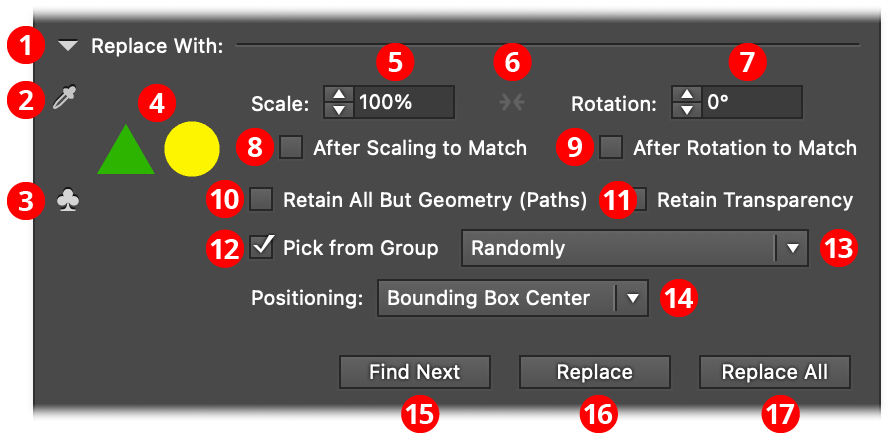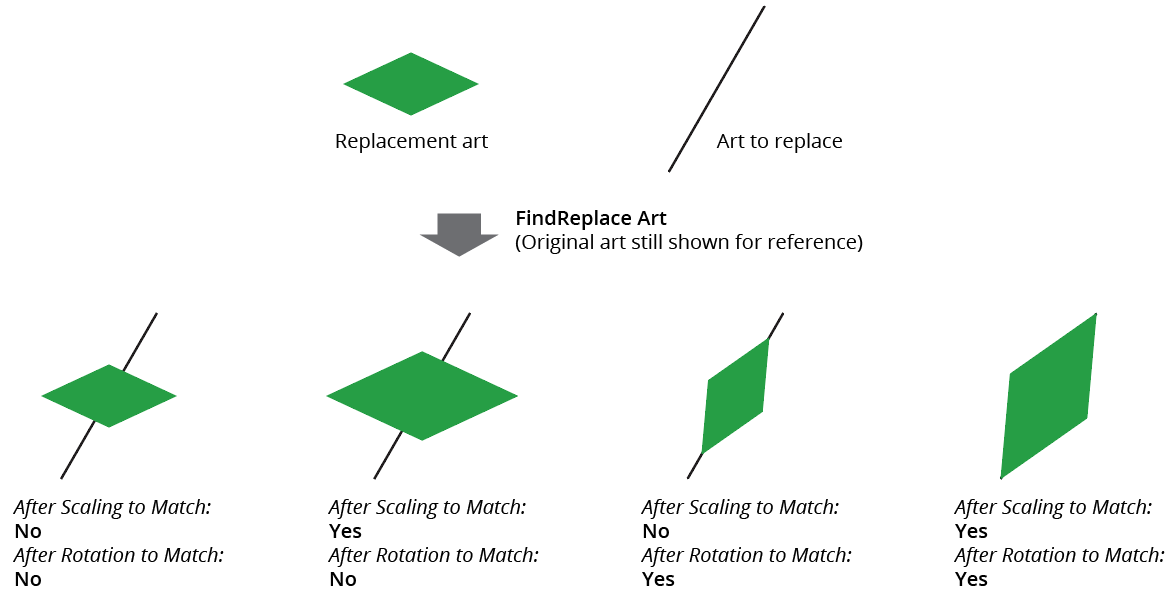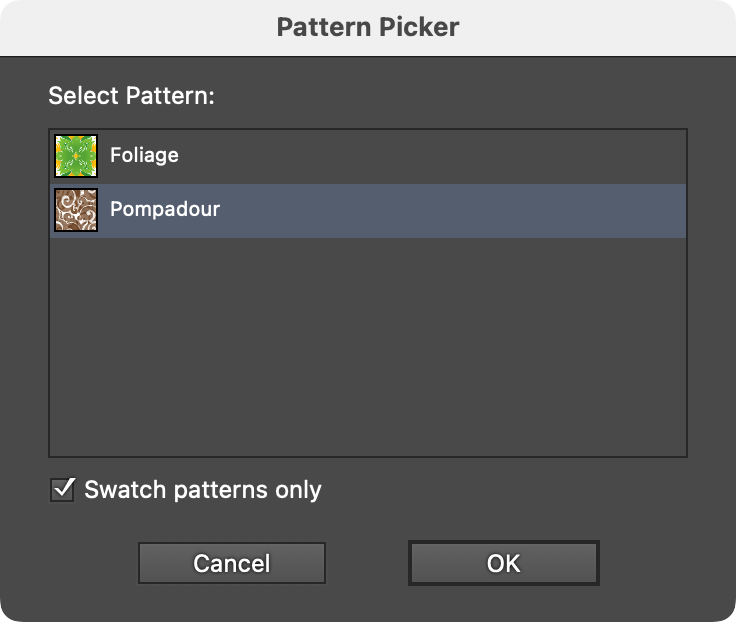 Replacing Art Panel
Replacing Art Panel
The lower part of the FindReplace Art panel is used to replace art which matches the search that is specified in the top section. The search buttons at the bottom of the top section do not need to be used before performing a replace operation.

FindReplace Art Panel Replace Art Area
1. Twirl-Down
Shows or hides the entire “Replace With” section of the panel.
2. Replacement Art Eyedropper
When a single art object is selected, clicking the eyedropper picks up the art as the replacement art. To use multiple pieces of art, they must be grouped (see Pick From Group, below).
3. Symbol Menu
If symbols exist in the document, this menu allows one of them to be selected, by name, to serve as the replacement art.
4. Replacement Art Preview Area
Shows a preview of the replacement art for the current document. This art is stored along with the document and will be automatically loaded into the FindReplace Art panel whenever the document is opened. Hovering the cursor over the preview area will show a brief text description of the art, which can be useful for art such as single point or no-stroke, no-fill paths, which are otherwise invisible. Guides may be used as replacement art. Clicking on the preview area switches its background between white and the panel background color (it will be automatically changed to the panel’s background color if the replacement art is entirely white).
5. Scale
The amount to scale the replacement art, from 1% to 10000%. Ignored when the replacement art is a ruler guide. Scaling honors the general Illustrator preference Scale Strokes & Effects.
6. Scale and Rotation Reset Button
Resets the Scale value to 100% and the Rotation value to 0°.
7. Rotation
The amount to rotate the replacement art. Ignored when the replacement art is a ruler guide.
8. After Scaling to Match
When enabled, the replacement art is first scaled to match the original art before being scaled by the overall Scale value. Scaling is matched using the larger of the width or height of the unrotated preview bounding boxes of each piece of art, unless the original art is a simple two-point straight line, in which case the line’s length is considered its size. The replacement art’s aspect ratio is always preserved.
9. After Rotation to Match
When enabled, the replacement art is first rotated to match the original art before being rotated by the overall Rotation value. Rotation is matched using the internal rotation information that Illustrator maintains for each art object, manifested in its bounding box, unless the original art is a simple two-point straight line (in which case the angle from the line’s start point to its end point is considered its rotation) or a rectangle (in which case the direction of the first longer edge is considered its rotation). Unless it is zero, the internal rotation value of the replacement art is noted in the tip text shown when the cursor is hovered over the replacement art preview chip.

FindReplace Art Replace Match Example
10. Retain All But Geometry (Paths)
When enabled, and both the original art and replacement art are paths, only the geometry of the replacement art will be used; i.e., the style (color, stroke weight, etc.) of the original art will be retained.

Retain All But Geometry Example
11. Retain Transparency
When enabled, the replacement art will keep the Blending Mode, Opacity, and Opacity Masks of the original art.
12. Pick From Group
When enabled, and the replacement art is a group, then the original art will not be replaced by the entire group, but rather by one of the members of the group. Which member is chosen for the replacement depends on the subsequent pop-up menu setting.
13. Pick From Group Type
Specifies how the members of the group are used as replacement art:
Consecutively: Each member of the group is chosen in consecutive order, with the member at the top of the group’s internal stacking order being chosen first. After reaching the last member, the cycle restarts with the first member again.
Consecutively (reverse order): Same as Consecutively, but the member at the bottom of the group’s internal stacking order is chosen first.
Randomly: Each member of the group is chosen at random each time.
Randomly (once through): Each member of the group chosen randomly, but once chosen, that member will not be chosen again. If there are more original art objects than replacement group members, then some of the original art will not be replaced.

Pick From Group Type Example
14. Positioning
Specifies how the replacement art is positioned with respect to the original art. In all cases the alignment point of the replacement art is the center of its bounding box, unless it is a group containing a single-point path that has been named “align”, in which case that point will specify the alignment point (the single-point path will be omitted from the group when the art is replaced).
Bounding Box Center: The replacement art is placed such that its alignment point is at the center of the original art’s bounding box.
First Anchor Point: The replacement art is placed such that its alignment point is at the original art’s first anchor point. If the original art is not a path, Bounding Box Center is used.
Last Anchor Point: The replacement art is placed such that its alignment point is at the original art’s last anchor point. If the original art is not a path, Bounding Box Center is used.
All Anchor Points: The replacement art is placed multiple times such that each copy has its alignment point at an anchor point of the original art. If the original art is not a path, Bounding Box Center is used.
Bezier Handles: The replacement art is placed multiple times such that each copy has its alignment point at a bezier handle of the original art (if any). If the original art is not a path, Bounding Box Center is used.

When the replacement position is an anchor point, the rotation that will be matched is the tangent angle of the path at that point; if the point is a corner point, the rotation is considered to be the perpendicular to the imaginary line that bisects the angle that the point creates in the path. When the replacement position is a bezier handle, the rotation that will be matched is the angle of the handle.
15. Show Next Button
Highlights and centers the view on the next art object which matches the top search.
16. Replace Button
Available after the Show Next button has been pressed. Replaces the current matching art with the replacement art using the current options, and then (unless the Option/Alt key is pressed) advances to the next matching art. Holding down Shift while pressing the button causes the matching art to be retained rather than replaced.
17. Replace All
Replaces all matching art with the replacement art using the current options. Holding down Shift while pressing the button causes the matching art to be retained rather than replaced; if originally selected, the art that was retained is deselected unless the Option/Alt key is also pressed.
Gradient and Pattern Pickers
For attributes which specify a gradient or pattern (such as a path stroke or fill), clicking on the color chip will being up the corresponding picker dialog.

FindReplace Art Gradient Picker

FindReplace Art Pattern Picker
In the Gradient Picker, Swatch gradients only controls whether only gradients that have associated swatches are shown in the list (there are often many unnamed gradients defined but not available as a swatch).
In the Pattern Picker, Swatch patterns only controls whether only patterns that have associated swatches are shown in the list.
